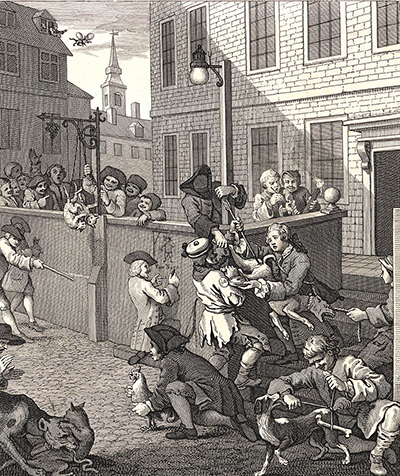William Hogarth's First Stage of Cruelty was the first in a series of four printed engravings published in 1751.
The series centred on the character of Tom Nero and were a kind of moral instruction. Hogarth hoped that these depictions would deter the lower classes from what he saw as the insufferable cruelty committed to animals on the streets of London. The style of the artwork deliberately lacked a lot of the finesse seen in much of Hogarth's work. The prints were intended to be printed cheaply so as to be distributed to the poorer classes.
The engraving shows the character Tom Nero inserting an arrow up the rectum of a dog, while another boy pleads with him to stop this bestial behaviour. It was suggested at the time that this boy represents the young King George the 3rd. In the background, two boys are depicted burning the eyes of a bird with a needle. Another group of boys are hanging two cats by their tails from a lamp post. Another cat is thrown from an upper floor window with two bladders attached to it. In the foreground a dog is being encouraged to tear the entrails from the inside of a poor, unfortunate cat and another boy is tieing a bone to the tail of a dog, thereby tormenting the dog by being tantalisingly out of reach.
Interestingly, in the centre of the scene, a boy is drawing a character hanging from a gallows in chalk on the wall. His other hand is pointing to Tom, a hint of what lies ahead for Tom Nero. Each engraving in the series see's Tom behaviour becoming worse until his final, grisly reckoning. The point of this series for William Hogarth was to show that the lack of guidance and control of young boys would lead to bad, irresponsible behaviour. Parish officers were required to police the youth but the financing for this was sadly neglected much of the time. It was hoped that these engravings would give some guidance to young, impressionable minds and reduce the bad treatment of animals, a cause close to Hogarth's heart.




